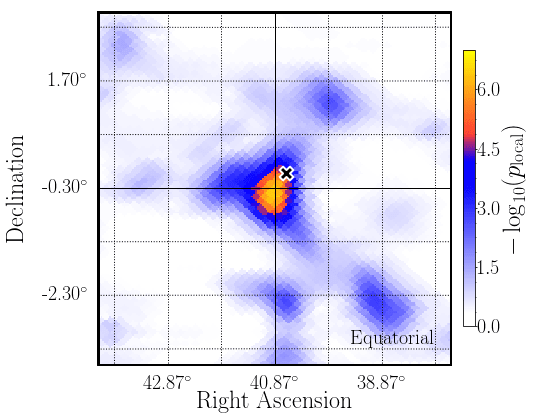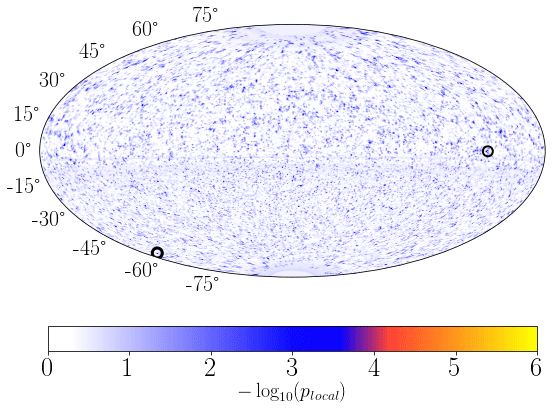For over a century, scientists have been observing very high energy charged particles called cosmic rays arriving from outside Earth’s atmosphere. The origins of these particles are very difficult to pinpoint because the particles themselves do not travel on a straight path to Earth. Even gamma rays, a type of high-energy photon that offers a little more insight, are absorbed when traversing long distances.
The IceCube Neutrino Observatory, an array of optical modules buried in a cubic kilometer of ice at the South Pole, hunts for cosmic-ray sources inside and outside our galaxy—extending to galaxies more than billions of light years away—using hints from elusive particles called neutrinos. These neutrinos are expected to be produced by cosmic-ray collisions with gas or radiation near the sources.
Unlike cosmic rays, neutrinos are not absorbed or diverted on their way to Earth, making them a practical tool for locating and understanding cosmic accelerators. If scientists can find a source of high-energy astrophysical neutrinos, this would be a smoking gun for a cosmic-ray source.
After 10 years of searching for origins of astrophysical neutrinos, a new all-sky search provides the most sensitive probe of time-integrated neutrino emission of point-like sources. The IceCube Collaboration presents the results of this scan in a paper submitted recently to Physical Review Letters.

Tessa Carver led this analysis under the supervision of Teresa Montaruli in the Département de Physique Nucléaire et Corpusculaire at the University of Geneva in Switzerland. “IceCube has already observed an astrophysical flux of neutrinos, so we know they exist and are detectable—we just don’t know exactly where they come from,” says Carver, now a postdoc at Cardiff University. “It is only a matter of time and precision until we can identify the sources behind this neutrino flux.”
The principle challenge in searching for astrophysical neutrino sources with IceCube is the overwhelming background of events induced by cosmic-ray interactions in our atmosphere. The signal of faint neutrino sources needs to be extracted via sophisticated statistical analysis techniques.
Using these methods, Carver and her collaborators “scanned” across the entire sky to look for point-like neutrino sources at arbitrary locations. This scanning method is able to identify very bright neutrino sources that could be invisible in gamma rays, which are also produced in cosmic-ray collisions.
In order to be sensitive to dimmer sources, they also analyzed 110 galactic and extragalactic source candidates, which have been observed via gamma rays. They then combined the results obtained for individual sources in this list in a “population analysis,” which looks for a higher-than-expected rate of significant results from the individual source list search. This allows researchers to find significant neutrino emission, even if sources in the list are too weak to be observed individually.
Researchers also employed a “stacking search” for three catalogs of gamma-ray sources within our galaxy. This search layers together all the emission from groups of known objects of the same type under the assumption that they have well-known emission properties. While it can significantly reduce the per-source emission required to observe a large excess of signal over the background, this search is limited in that it requires more knowledge of the sources in the catalog.

While the different analyses did not discover steady neutrino sources, the results are nevertheless exciting: some of the objects in the catalog of known sources showed a higher neutrino flux than expected, with excesses at the 3σ-level. In particular, the all-sky scan revealed that the “hottest” location in the sky is just 0.35 degrees away from the starburst galaxy NGC 1068, which has a 2.9σ excess over background. NGC 1068 is one of the closest black holes to us; it is embedded in a star-forming region with lots of matter for neutrinos to interact with while the high-energy gamma rays are attenuated, as shown by Fermi and MAGIC measurements. This is the most significant excess seen besides TXS 0506+056, the 2017 source that IceCube found to be coincident with a gamma ray flare. Still, these potential neutrino sources require more data with a more-sensitive detector, like IceCube-Gen2, to be confirmed.
The researchers also found that the Northern Hemisphere source catalog as a whole differed from background expectations with a significance of 3.3σ. Carver says these results demonstrate a strong motivation to continue to analyze the objects in the catalog. Time-dependent analyses, which search for flares of peaked emission, and the possibility of correlating neutrino emission with electromagnetic or gravitational wave observations for these and other sources may provide additional evidence of neutrino emission and insights into the neutrinos’ origin. With continued data-taking, more refined direction reconstruction, and the upcoming IceCube Upgrade, further improvements in sensitivity are on the horizon.
“We are lucky to have the unique opportunity to be the first people to map the universe with neutrinos, which provides a brand-new perspective,” says Carver. “Also, this progress in neutrino astronomy is accompanied by great strides in gravitational wave physics and cosmic-ray physics.”
Montaruli adds, “While we are at the dawn of a new era in astronomy that observes the universe not just with light, this is the first time we have begun to see potentially significant excesses of candidate neutrino events around interesting extragalactic objects in time-independent searches.”
info “Time-integrated Neutrino Source Searches with 10 years of IceCube Data,” IceCube Collaboration: M. G. Aartsen et al., Physical Review Letters 124, 051103 (2020), journals.aps.org, arxiv.org/abs/1910.08488